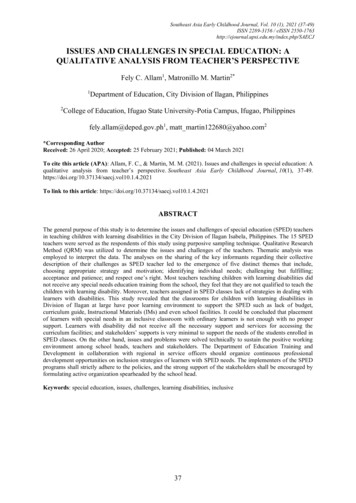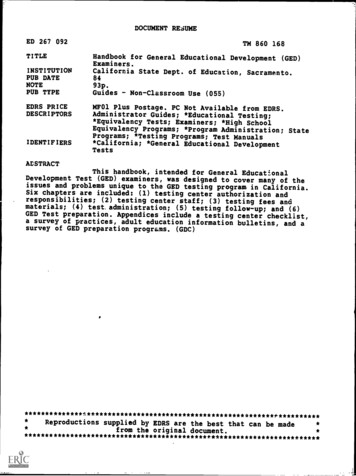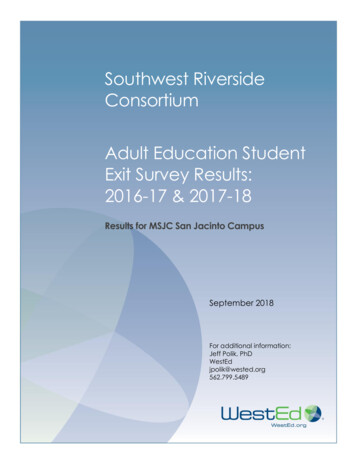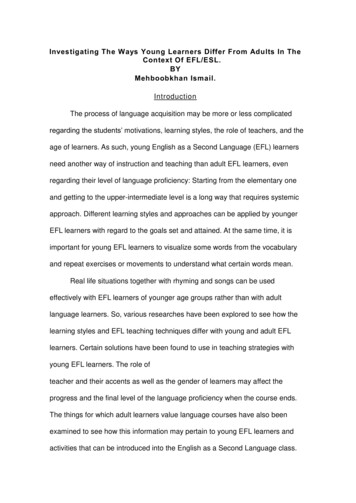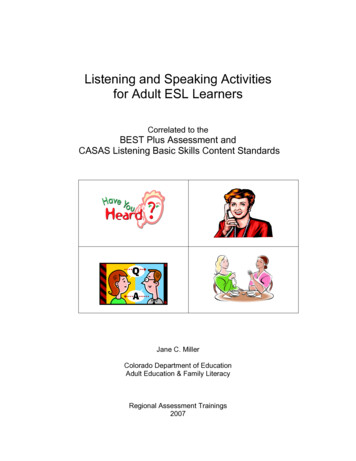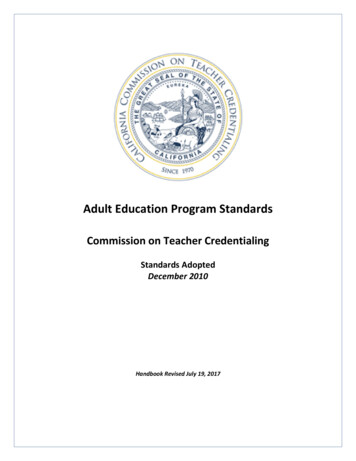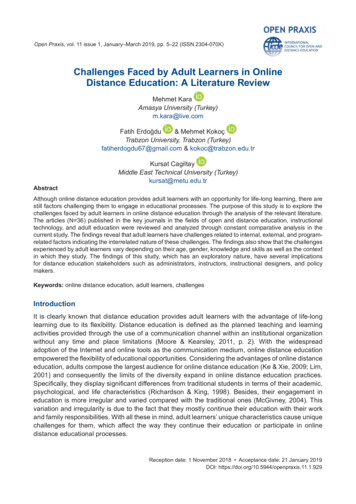
Transcription
OPEN PRAXISOpen Praxis, vol. 11 issue 1, January–March 2019, pp. 5–22 (ISSN 2304-070X)INTERN/ITION/llCOUNCIL FOR OPEN ANDDISTANCE EDUCATIONChallenges Faced by Adult Learners in OnlineDistance Education: A Literature ReviewMehmet KaraAmasya University (Turkey)m.kara@live.com& Mehmet KokoçFatih ErdoğduTrabzon University, Trabzon (Turkey)fatiherdogdu67@gmail.com & kokoc@trabzon.edu.trAbstractKursat CagiltayMiddle East Technical University (Turkey)kursat@metu.edu.trAlthough online distance education provides adult learners with an opportunity for life-long learning, there arestill factors challenging them to engage in educational processes. The purpose of this study is to explore thechallenges faced by adult learners in online distance education through the analysis of the relevant literature.The articles (N 36) published in the key journals in the fields of open and distance education, instructionaltechnology, and adult education were reviewed and analyzed through constant comparative analysis in thecurrent study. The findings reveal that adult learners have challenges related to internal, external, and programrelated factors indicating the interrelated nature of these challenges. The findings also show that the challengesexperienced by adult learners vary depending on their age, gender, knowledge and skills as well as the contextin which they study. The findings of this study, which has an exploratory nature, have several implicationsfor distance education stakeholders such as administrators, instructors, instructional designers, and policymakers.Keywords: online distance education, adult learners, challengesIntroductionIt is clearly known that distance education provides adult learners with the advantage of life-longlearning due to its flexibility. Distance education is defined as the planned teaching and learningactivities provided through the use of a communication channel within an institutional organizationwithout any time and place limitations (Moore & Kearsley, 2011, p. 2). With the widespreadadoption of the Internet and online tools as the communication medium, online distance educationempowered the flexibility of educational opportunities. Considering the advantages of online distanceeducation, adults compose the largest audience for online distance education (Ke & Xie, 2009; Lim,2001) and consequently the limits of the diversity expand in online distance education practices.Specifically, they display significant differences from traditional students in terms of their academic,psychological, and life characteristics (Richardson & King, 1998). Besides, their engagement ineducation is more irregular and varied compared with the traditional ones (McGivney, 2004). Thisvariation and irregularity is due to the fact that they mostly continue their education with their workand family responsibilities. With all these in mind, adult learners’ unique characteristics cause uniquechallenges for them, which affect the way they continue their education or participate in onlinedistance educational processes.Reception date: 1 November 2018 Acceptance date: 21 January 2019DOI: https://doi.org/10.5944/openpraxis.11.1.929
6Mehmet Kara et al.Adult LearningAdult learners have distinct characteristics in comparison to traditional students. Firstly, theyare aware of why and what they need to learn (Knowles, 1996). It is also known that the adultlearners, who have diverse educational background and goals, want to reflect their experienceson their educational process (Lindeman, 2015). They are different from other learners in terms oftheir responsibilities in their daily lives, which influence their educational experience (Cercone,2008). For this reason, there is a need for an educational environment where adult learners areallowed to determine their own educational processes; to share their ideas comfortably; and tosustain their educational process alongside their private lives. Thus, online distance educationenvironment offers appropriate opportunities through the flexibility it provides for adult learners,who are aware of their own learning responsibilities and are required to manage their own learningprocesses.In spite of the increase in the number of adult learners and consequently in the diversity of thestudents in online distance education, the number of the studies related to them are fewer in theliterature than those studies about traditional learners (Chu & Tsai, 2009; Ke, 2010; Remedios &Richardson, 2013). Adult learners can be classified as young and older adults depending on their ages.However, adult learner can be defined as the ones who continue their education by balancing theirfamily and work and are generally older than 22 (Kahu, Stephens, Leach & Zepke, 2013) and thesecharacteristics makes them quite different from traditional learners. Although these differences mightprovide adult learners with some advantages in educational processes, they might lead to variouschallenges as well. As a consequence, these point out the need to plan educational environmentsand processes in accordance with these learners’ characteristics.Adult Learners in Online Distance EducationConsidering the learner-centered nature of all instructional design models, it is a necessity to designand implement online distance education programs that meet the needs of diverse learners includingadults. This requires a sound understanding of the link between adult learners’ characteristics andthe appropriateness of the online environments for their online experiences.Learners can manage learning processes wherever and whenever they desire through the onlinelearning environments. Additionally, adult learners have an opportunity to engage in more interactionvia the tools (e.g. discussion and chat) offered by online learning environments (Kim, Liu & Bonk,2005). By this way, they can develop virtual teaming skills and control their own learning processes(Kim, Liu, & Bonk, 2005). Interaction is also considered as a key factor in online distance educationand it is a good predictor of learning (Picciano, 2002). Online distance education also provides anopportunity for learners to engage in individualized instruction and thus learning processes canbe planned in harmony with their characteristics (Means, Toyama, Murphy, Bakia & Jones, 2009).Furthermore, one of the most fundamental and crucial benefits of online distance education foradults is the opportunity for life-long learning.In addition to the advantages of distance learning mentioned above, it is known that especiallyadult learners face particular challenges during their online education. Computer and Internet selfefficacy of adult learners play a significant role in online learning processes (Johnson, Morwane,Dada, Pretorius & Lotriet, 2018). The learners who have low perception of competency in theseissues or the older adult learners might have challenges in this process and this might cause learnerdropout (Appana, 2008). The problems related to learner support might also be experienced inOpen Praxis, vol. 11 issue 1, January–March 2019, pp. 5–22
Challenges Faced by Adult Learners in Online Distance Education: A Literature Review7online distance education. It might be the case that adult learners do not have available supportthrough the related resources and orientation programs as college students do. Therefore, theymight feel isolated in their educational experience. The challenges they experienced in educationmight increase when they lack of adequate support from their families and workplaces. In addition,adults have multiple roles such as spouse, parent, colleague, and student, each of which meansadditional responsibilities and workload (Thompson & Porto, 2014). These challenges mightaffect their learning success as well as causing dropout in online distance education programsor courses (Park & Choi, 2009). Increasing dropout rates are considered as a crucial problem indistance adult education. One study by Choi and Kim (2018) examined meaningful factors affectingadult distance learners’ decisions to drop out. Their study found that some of the factors affectedadult learners’ decisions to persist in or drop out of the online degree programs such as basicphysical constraints from work, scholastic aptitude, family/personal issues, motivation for studying,academic integration, interaction, and motivation (Choi & Kim, 2018). In another major study, Lee,Choi and Kim (2013) found that academic locus of control and metacognitive self-regulation skillswere the more important factors influencing the dropout of adult learners. Deschacht and Goeman(2015) emphasized that future studies should be focused on preventing the dropout of adult onlinelearners. These studies showed that the external and internal challenges faced by adults increasedthe likelihood of adult learners’ dropout. Due to the high rates of dropout, particularly by adultlearners as a result of the challenges they faced, student retention is now considered as a successfactor in online distance education programs (De Paepe, Zhu & DePryck, 2018; Martinez, 2003).Thus, there is also an immense need to focus on these challenges in online distance educationpractices.Former research has concentrated on what to do to improve quality and adult learners’ performancein online distance education (Johnson et al., 2018; Thompson & Porto, 2014). In the review ofthe literature, it is observed that the relevant studies focus on a single component of distanceadult education. For this reason, it seems significant to create a framework and explore currentlandscape regarding the mentioned challenges for the future studies in adult distance education.Recent studies addressed that a holistic understanding of the problems and challenges faced byadults in online distance education plays a key role in building effective online learning experiences(Wang, 2011; De Paepe et al., 2018). Therefore, the purpose of this study is to investigate thechallenges faced by adult learners in online distance education through the review of the relatedliterature so as to create such a framework. Specifically, the current study strives to answer theresearch question: What are the identified challenges faced by adult learners at a distance in theliterature?MethodThe present study used systematic literature review procedures. The research studies in the literaturereporting the challenges faced by adults were systematically reviewed and analyzed. The followedprocedure was presented in the following sections.Inclusion and Exclusion CriteriaSeveral criteria were determined for the inclusion of the studies. The main inclusion criterion wasthat the reviewed studies had to be conducted in the contexts of online distance education programsOpen Praxis, vol. 11 issue 1, January–March 2019, pp. 5–22
8Mehmet Kara et al.offering academic degrees. Therefore, the studies about corporate trainings and Massive OpenOnline Courses (MOOCs) were excluded from the study because only the studies reporting thefindings from the online distance education programs offering academic degrees were aimed to beincluded. Based on this main criterion, other inclusion and exclusion criteria were identified to review.Considering the developments in online distance education, the studies published since 2000 wereincluded in this study. As another basic inclusion criterion, only the empirical journal articles wereincluded; that is, the book reviews, literature reviews, meta-analysis studies, editorials, and conferenceproceedings were excluded in the current study. Furthermore, merely the articles published in peerreviewed journals were included.In accordance with the aim of this study, the journal articles aiming to investigate the challengesof adult learners in online distance education were included. As another criterion, the participants ofthe studies needed to be adult learners in that the studies either stated the ages of the participantsexplicitly or the participants were adult learners at a distance. The participants of the studies wereaccepted as adults only if they met the adult learner definition by Kahu et al. (2013). Since thefocus of the current study is on reviewing the studies exploring adult learners’ challenges, only thequalitative, mixed methods, or descriptive studies were included. Additionally, it is obvious in theliterature that some challenges faced by adult learners cause dropouts in online distance educationprograms. For this reason, the journal articles aiming to investigate the reasons for dropout behaviorof adult learners were also included in the present study.Data Collection and AnalysisThe data collection started with a comprehensive search on the electronic databases and thetables of contents of the key journals publishing distance education and adult learning articles.The e-databases on which the search was conducted are Web of Science, SAGE JournalsOnline, Educational Resources Information Center (ERIC), Wiley Online Library, ScienceDirect,SpringerLink, and Taylor & Francis Online Journals. The search was conducted by using thekeywords: distance education, adult learning/learners, challenges, obstacles, dropout, persistence,and retention.The tables of the contents of the 36 key journals in distance education, instructional technology,adult and lifelong education were specifically reviewed. The journal articles were reviewed in termsof their aims, methods, contexts, and results. Finally, 36 journal articles included in this study wereidentified. The list of the journal articles reviewed in the current study are presented in Table 1. Thedemographics of the participants in the reviewed articles are also presented in Table 2.The data analysis was conducted in three phases: organization of the articles, reduction of thefindings in the articles through coding, and illustration of the findings via tables and a figure. Thearticles were firstly organized in an article database created by the researchers and were analyzed byusing Constant Comparative Analysis method as suggested by Glaser (1965). Constant comparativeanalysis was used to compare and contrast the challenges that are encountered by adult learnersat a distance reported in the studies. The challenges reported in the articles were coded and thencategorized based on their similarities and differences. The analysis results were reported bycomparing and contrasting the concepts and integrating the studies. The themes were created byadapting Willging and Johnson’s (2009) category of dropout reasons. They were grouped as theinternal challenges directly related to the adult learners’ characteristics, the external challengesaffected by the study conditions, and institutional challenges stemming from the educationalorganization responsible for the delivery of the instruction.Open Praxis, vol. 11 issue 1, January–March 2019, pp. 5–22
Challenges Faced by Adult Learners in Online Distance Education: A Literature Review9Table 1: Articles reviewed in this studyNumberAuthor(s)YearResearch TypeResearch Context1Calvin & antitativeUndergraduate3Dumais, Rizzuto, Cleary &Dowden2013Mixed MethodAn online degree program4Dzakiria2012QualitativeNo information5Erickson & itativeA language Course7Grace & Smith2001QualitativeA vocational training course8Joo2014QualitativeUndergraduate9Kahu, Stephens, Zepke & Leach2014QualitativeUndergraduate10Nor2011Mixed MethodUndergraduate11Östlund2005Mixed MethodUndergraduate12Park & Choi2009QuantitativeHigh school,Undergraduate,and Graduate13Pierrakeas, Xeno,Panagiotakopoulos & Vergidis2004QualitativeUndergraduate andgraduate14Rao & Giuli2010Mixed MethodGraduate15Selwyn2011QualitativeUndergraduate and er2003QualitativeGraduate18Vergidis & g & Johnson2004QualitativeGraduate20Xenos, Pierrakeas & alitativeGraduate22Zhang & veAn online course24De Paepe et al.2018QualitativeEducators25Vanslambrouck, Zhu, Tondeur,Philipsen & Lombaerts2016QualitativeTeacher Training Program26Gravani2015QualitativeHigher Education System27Choi & Kim2018QuantitativeOnline Degree Program28Choi & Park2018QuantitativeOnline Degree ProgramContinuedOpen Praxis, vol. 11 issue 1, January–March 2019, pp. 5–22
10Mehmet Kara et al.Table 1: ContinuedNumberAuthor(s)YearResearch TypeResearch Context29Knestrick et aduate31Musita, Ogange & ativeGraduate33Chang & Kang2016QuantitativeGraduate34Kim & Park2015QuantitativeGraduate35Thistoll & Yates2016QualitativeDistance Vocational Education36McGee, Windes & Torres2017QualitativeOnline Teaching ExpertReview ProcedureFollowing the identification of the research studies based on the relevant literature and inclusioncriteria, the abstracts and findings sections of these studies were reviewed. The abstracts werefirstly reviewed to find out an indicator or clue of a challenge causing problems or dropoutfor adults. When an indicator or clue was not found in the abstract, the findings section wasreviewed. In the findings section, it was aimed to identify whether there were findings regardingthe challenges and whether these findings were related with adults. Finally, the identified findingswere coded.Table 2: Participants in the articles reviewed in this studyNumberAge (Mean or Range)Female-Male leKorea925-5915-4New eSweden1220-Above 40105-42KoreaContinuedOpen Praxis, vol. 11 issue 1, January–March 2019, pp. 5–22
Challenges Faced by Adult Learners in Online Distance Education: A Literature Review11Table 2: ContinuedNumberAge (Mean or Range)Female-Male lableUSA1521-7130-30Africa, Asia, Australia, Europe, 9Europe, Asia da, Japan, China, navailableUnavailableNew Zealand36UnavailableUnavailableUSAFor the internal validity of the study, the reviewed studies and the findings were checked by asubject field expert along with the researchers and the required revisions were made, consequently.As for the external validity, the qualitative findings were analyzed according to Willging and Johnson’s(2009) category of dropout reasons of adults. As for the reliability, the data collection procedure,including the databases and keywords and data analysis, were clearly reported so that the study canbe easily replicated. Figure 1 illustrates the phases of the analysis of a reviewed article and how thefindings were coded.Open Praxis, vol. 11 issue 1, January–March 2019, pp. 5–22
12Mehmet Kara et al.Review the abstractIs the abstract related todistance education?N"-- - - -YESAre the participants adultstudents?NO- FINISHYESIs there any avaliableindicator or clue about thehallanges they face?N' -------'YESReview thefindings/results andcreate codes andthemes1---------- ,Figure 1: Data Collection Procedure and Decision-Making ProcessFollowing the procedure demonstrated in Figure 1, 36 articles meeting the pre-determined inclusioncriteria were identified and included in the current study. Diverse codes and themes were revealedthrough the detailed review of the abstracts and findings of these articles.Findings and DiscussionThe challenges experienced by adults were organized as themes depending on the properties of thechallenges. The identified themes were internal, external, and program-related challenges.Internal ChallengesThe internal challenges include adult learners’ individual challenges related to their own characteristics.The internal challenges experienced by adult learners are classified as Management Challenges,Learning Challenges, and Technical Challenges as demonstrated in Table 3.Open Praxis, vol. 11 issue 1, January–March 2019, pp. 5–22
Challenges Faced by Adult Learners in Online Distance Education: A Literature Review13The first sub-theme found in the literature is management challenges. In the literature there is aconsensus on the fact that adult learners are different from traditional students since they have familyand work responsibilities. For this reason, they need to manage their family and work while continuingtheir education. This requisite is reported in many of the studies in the literature as the source of amajor challenge for adults; creating balance between work and family or other social responsibilities(Doherty, 2006; Selwyn, 2011; Yasmin, 2013). Particularly, female learners are reported as the oneswho are mostly challenged by such family responsibilities as childcare and domestic works as well astheir work if they are employed (Selwyn, 2011). Correspondingly, adult learners are required to havetime management skills or appropriately structure or schedule their studies to create this balance(Calvin & Freeburg, 2010; Zhang & Krug, 2012). If they have insufficient or lack of time managementskills, then this causes another challenge for them to continue their education or to successfullycomplete distance education program. The review regarding the internal challenges indicated thatmiddle-aged adults (between the ages of 36 and 55) are unable to create a balance between theireducation and work, family, and social life. Additionally, female learners who were married and hadchildren generally have challenge to establish balance between their family and education and theycould not give adequate importance to their education, accordingly (Selwyn, 2011).Table 3: Internal challenges faced by Adult Learners in Distance ty to create balance between education and work14Inability to create balance between education and family or social life14Difficulty in time management6Less commitment to education6Lack of interest in program or materials2Inability to understand course materials1Lack of prerequisite knowledge3Low concentration on study1Low self-confidence1Difficulty in communication through the internet3Insufficient computing skills9Difficulty in accessing reliable information1The second sub-theme is learning challenges. The aforementioned management challengesinfluence adults’ commitment to their education and less commitment to education poses one of thelearning challenges for them as reported by Dumais et al. (2013). Yasmin (2013) found out that theadult learners who start to study after a long period of time have a difficulty focusing on studying. Inaddition to these personal challenges, some factors pertaining to distance education programs alsopose learning challenges for adults when an inconsistency between the program and learners occurs.In their study, Willging and Johnson (2009) reported that lack of interest in a program or learningmaterials is a source of challenge for adults. Pierrakeas et al. (2004), on the other hand, indicated thatlearners’ inability to understand course materials and their lack of prerequisite knowledge or skills fora course might be also challenges for traditional learners. The review showed that middle-aged adultshave challenges to concentrate on studying and course materials owing to their busy work life.Open Praxis, vol. 11 issue 1, January–March 2019, pp. 5–22
14Mehmet Kara et al.The final sub-theme is technical challenges especially experienced by older adults. The studiesconducted with older adults reported that technology usage poses a challenge for them. For example,in his study with undergraduate students who are 50 and older, Nor (2011) reported that communicationon the Internet is a challenge for adult learners. In another study with graduate adult learners who arebetween 50 and 65 by Erickson and Noonan (2010), it was reported that the lack of technical skillsmakes the instructional process challenging for learners. The same finding was also reported in thestudy with the students who are between 41 and 51, by Dzakiria (2012). He additionally revealed thataccessing reliable information via the Internet is another challenge for adults. The review findingsdemonstrated that the older adults who are 50 and above unlike the young and middle-aged adultshave difficulty to participate in the collaborative activities satisfactorily due to the insufficient technicalskills and insufficient interaction on the internet (Nor, 2011; Dzakiria, 2012; Chang & Kang, 2016).External ChallengesThe external challenges include the challenges stemming from work and domestic environmentsor from responsibilities of adult learners as independent from their personal characteristics. Theexternal challenges are categorized into two sub-themes as Job-related and Domestic challengesas shown in Table 4.Employed adults have challenges concerning their jobs. Even if they have the ability to create thebalance between work and education, they could not find the needed time to meet the course orprogram requirements when they were overloaded with their works as reported by Dumais et al. (2013).Likewise, Willging and Johnson (2009) revealed that varying job responsibilities are also a challengefor adult learners. They also reported that when the adults had jobs that did not have a pre-determinedwork schedule or had financial problems, there were high rates of dropout in the distance educationprograms. It was observed that this challenge was faced by the employed middle-aged adults wholived in the countries with high population (e.g. USA, China, India, and Canada), and thereby who hadbusy work schedule. In this regard, they needed support from the organizations where they workedto meet the educational requirements. Lack of organizational support was reported as either the mainsource of the challenges or as a factor that made it difficult for adults to deal with these challenges inseveral studies (Joo, 2014; Park & Choi, 2009; Willging & Johnson, 2009). Due to heavy workload,lack of organizational support, schedule conflicts or, sometimes, family responsibilities –especially forfemale learners–, adults tend to have limited time to allocate for their education (Erickson & Noonan,2010; Kahu et al., 2014; Rao & Giuli, 2010; Venter, 2003; Willging & Johnson, 2009; Zembylas, 2008).Table 4: External challenges faced by Adult Learners in Distance EducationSub-ThemesJob-Related ChallengesDomestic ChallengesConceptsFrequencyWork overload1Lack of employing organization’s support2Schedule conflicts1Financial problems1Limited time to study6Technical problems6Limited environment to study5Lack of family support4Open Praxis, vol. 11 issue 1, January–March 2019, pp. 5–22
Challenges Faced by Adult Learners in Online Distance Education: A Literature Review15One of the domestic challenges is concerned with technical problems such as disconnectionproblems and lack of broadband Internet speed experienced by adults in their study locations(Dzakiria, 2012; Kahu et al., 2014; Ostlund, 2005; Rao & Giuli, 2010). For example, in their studywith mature age learners, Kahu et al. (2014) reported that some of the learners had technicalproblems in participating in the educational activities at their home and they could not studyin their workplaces. This challenge is partially a source of another challenge, which is limitedphysical environment to study (Kahu et al., 2014; Selvyn, 2011; Zembylas, 2008; Zhang & Krug,2012). In his study with undergraduate and graduate adults, Selwyn (2011) indicated that thelack of suitable physical environment to study is particularly a challenge for females since theyhave multiple responsibilities aside from their education such as childcare, household works, andtheir job-related works if they are employed. In this respect, adults need to have family supportfor their education as well as organizational support. Otherwise, lack of family support becomesanother domestic challenge (Willging & Johnson, 2009; Zembylas, 2008). In his study withgraduate students, Zembylas (2008) reported that family support served to help adult learners todeal with many of the problems they encountered and to create a balance between their familyresponsibilities and education.Program-related ChallengesIn online distance education, the context of each program might be also a source of challenge itselffor learners, which is called in this study as program-related challenges. These sorts of challengesinclude the ones pertained to the distance education program in which adults participate in educationalactivities. Within this theme, there were two sub-themes called ‘tutor-related’ and ‘institutionalchallenges’ as demonstrated in Table 5.The literature indicates that adults suffer from insufficient interaction with both tutors and otherstudents. Tutors clearly influence learners’ satisfaction and success in both distance educationand traditional education settings. Tutors’ ineffective interaction with learners brings aboutseveral learning challenges (Dumais et al., 2013; Dzakiria, 2012; Joo, 2014; Ostlund, 2005;Venter, 2003). Tutors’ interaction problems with learners might arise when the tutors have limitedcommunication with learners (Joo, 2014), or fail to provide them with any response (Dumaiset al., 2013), or with timely response (Dzakiria, 2012). The lack of sufficient feedback
tables of contents of the key journals publishing distance education and adult learning articles. The e-databases on which the search was conducted are Web of Science, SAGE Journals Online, Educational Resources Information Center (ERIC)Wiley Online Library, ScienceDirect, , SpringerLink, and Taylor & Francis Online Journals.The search was conducted by using the
